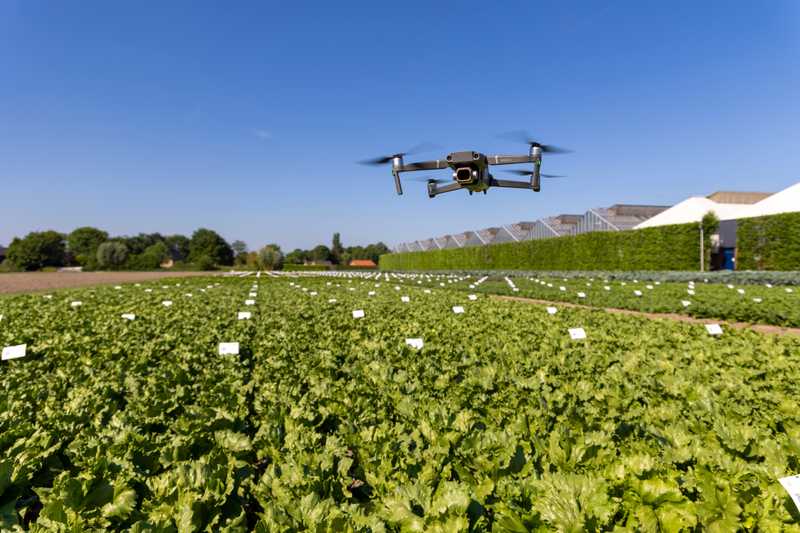
How Rijk Zwaan Uses Drone Plant Counts to Accelerate Vegetable Breeding Programs
August 10, 2022
Rijk Zwaan is one of the world’s top vegetable breeders, representing nine percent of the global vegetable seed market. Their plant breeding researchers improve the agronomic and qualitative traits of a large portfolio of vegetable crops every year by running different trials that include hundreds of breeding lines around the world. Some examples of these vegetable varieties include leafy green crops like lettuce, spinach and brassicas, root crops such as carrot, beetroot, and fruit crops like cucumber, pepper, tomato and melon. Released varieties are widely used in commercial production and vegetable processing markets.
Breeding new vegetable varieties can take between 6-16 years of rigorous evaluation before a package of traits is expressed stably enough for commercial release. Historically, plant improvement has been slow. But demand and digital phenotyping are quickening the pace.
To expedite their breeding pipeline, Rijk Zwaan adopted drone imagery to assist in characterizing phenotypes of promising breeding lines and to document their volumes of vegetable trials.
We work hard to assess different phenotypic traits of breeding lines under diverse field conditions around the world. This requires measuring a whole field of individual plants, which can be very time consuming and laborious,” said Wex Woo, Digital Phenotyping Specialist at Rijk Zwaan Australia. “The capability of a drone to quickly measure simple traits in a high-throughput manner allows our breeders and selectors to focus their efforts on assessing more complex traits, which speeds to our customers more climate-resilient varieties with better traits.
Details
Partner: Rijk Zwaan
Crops: Lettuce, Beetroot, Carrot, Melon, Spinach and many more
Location: Australia/Netherlands
Farm size: Multiple international sites
Hardware: DJI M210 RTK V2, DJI P4 RTK, MicaSense RedEdge-MX
Software: Plant Counts with Plant AI™, Plant Health Crop Indices, Zonal Statistics
Flight Altitude: 3–20 meters AGL (Above Ground Level)
Number of flights: ~100 per season, 1-3 flights/trials
Image resolution: from under 0.1 cm/pixel to 0.5 cm/pixel
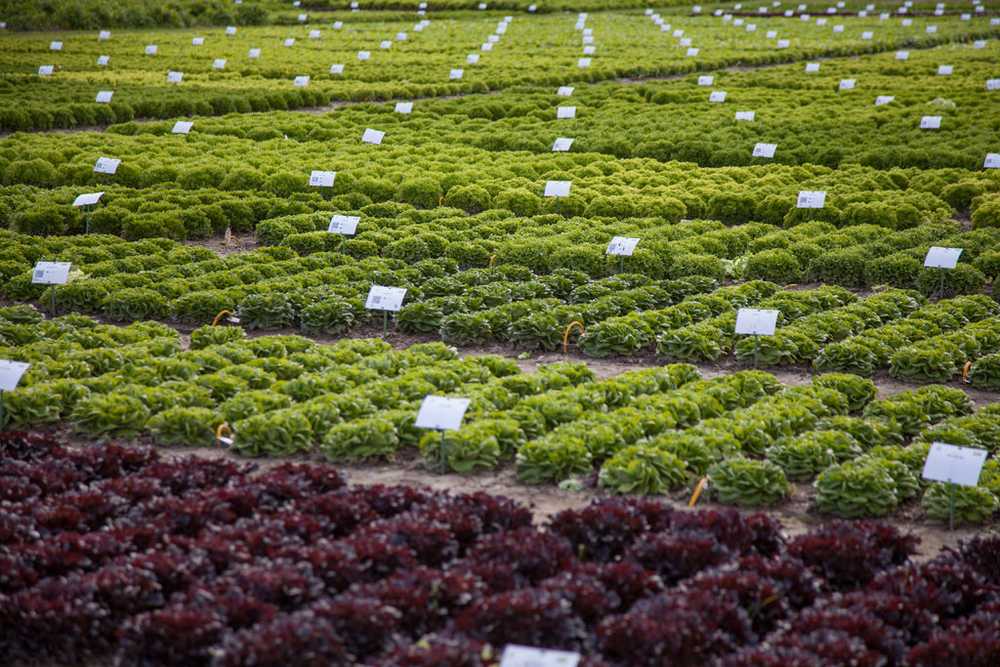
Situation
Rijk Zwaan conducts thousands of vegetable trials per year, reinvesting 30% of its annual earnings in research & development. An emphasis on innovative technology to assist in their breeding programs led them to integrate drones in their trial inspections. Researchers regularly fly breeding plots – both in the field and the greenhouse – to evaluate promising crosses’ suitability for various markets and growing conditions.
Because breeders evaluate multiple varieties per field and must document a large number of plots several times per lifecycle, datasets can be immense. Manual inspections were slow, labor-intensive, and unsustainable for their rapidly growing business.
Rijk Zwaan has begun automating trial plot inspections with drone imagery, which accelerates data collection, eliminates subjective note-taking, and allows them to share data across a diverse team.
They are increasingly integrating drone data in their evaluations to improve inspection efficiency and reliability, uncover hidden crop variables, and document plant-level data in bulk.
With multiple vegetable crops and wide variations in colors and leaf shapes within species, Rijk Zwaan needed a smart but flexible analytics tool that could accommodate all of their trial parameters. Solvi’s powerful but instinctive algorithms fit the bill.
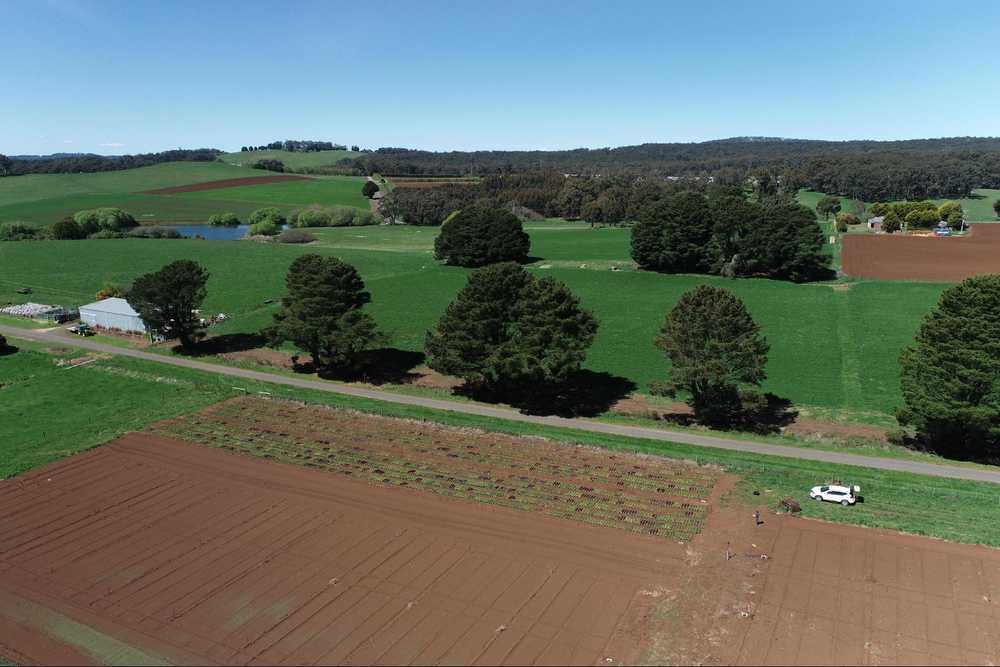
Research Goals
- Improve research plot inspection accuracy, objectivity, and efficiency
- Investigate plant-level data for trait expression, in lettuce:
- Plant size
- Disease-resistance
- Maturity date
- Color intensity (red and green leaf varieties)
- Plot density
- Monitor variety changes/trait expression over time
- Share equivalent data for remote collaboration with team members
Assessment Strategy
With an experienced, highly specialized team, Rijk Zwaan had tried several drone software providers but wanted a single solution that worked on multiple vegetable types and provided varying degrees of detail for the team.
We are amazed that Solvi’s Plant AI™ detection model is robust enough to work on different crop types from seedlings to crops to fruits, with relatively little labeling required. The model training was also surprisingly easy to use and intuitive,” Woo said.
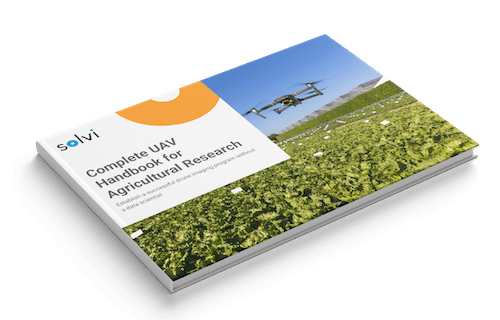
Download The Complete UAV Handbook for Agricultural Research
Learn how to establish a successful drone imaging program without a data scientist
Get your free pdfTrial Plot Inspection Drone Insights
1. Plant Counts for Leafy Greens and Vegetables
Solvi’s Plant Counts feature provides a quick and accurate headcount of all plants in each trial. And it works for multiple leaf shapes and colors in the same field (or greenhouse).
Because users train the Plant AI™ algorithm, the user defines the range of acceptable characteristics. With a few clicks, Rijk Zwaan can count and visualize statistical ranges of mixed leafy green or multiple salad lettuce plots.
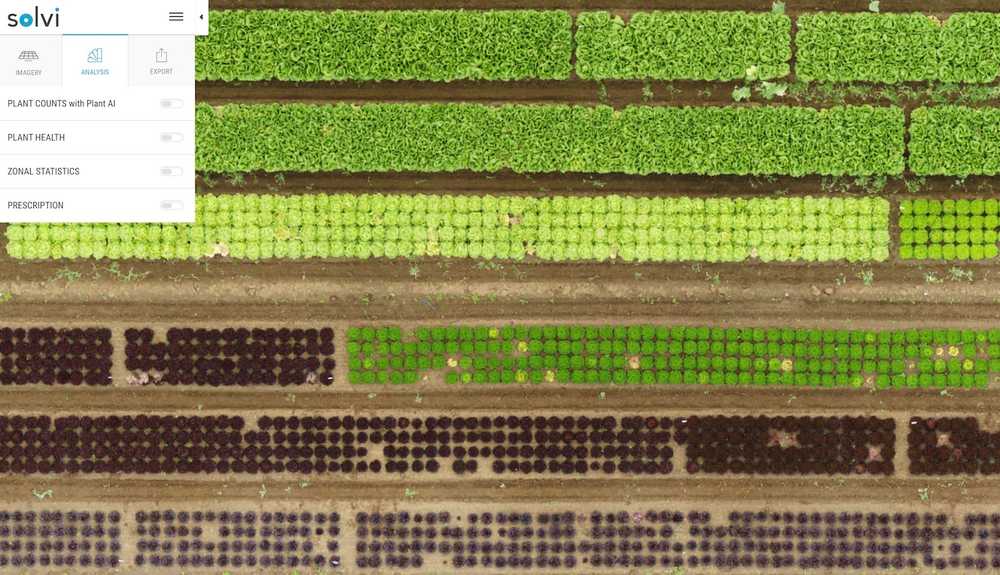
Brassica and Other Plant Counts
Solvi’s Plant Counts works on more than leafy greens. Brassicas like cabbage and broccoli can be easily counted and measured as well as tomato plants and vining crops like melon, cucumbers, and pumpkins.
Rijk Zwaan uses Plant Counts in brassica trials to accurately count plants, size harvestable heads, and evaluate growth uniformity in response to fertilizer rates.
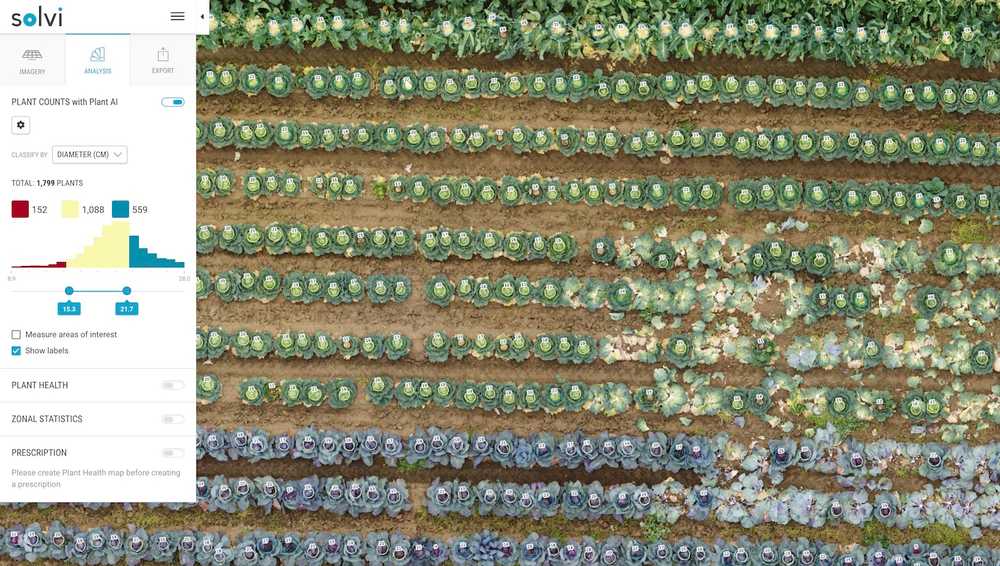
Vegetable Harvest Counts
Rijk Zwaan has also successfully used drone imagery to count harvestable fruit in watermelon, carrots, and beets for variety selection.
The diversity of vegetable crops offered by Rijk Zwaan continues to grow every year, so working across many different breeding programs adds to the challenge of digitally phenotyping compared to working with just one crop type,” said Mike Poodt, Team Leader Information Management R&D.
In addition to plant counting, the Plant AI™ algorithm allows researchers to measure vegetable plant height, density, diameter, area, and fruit size.
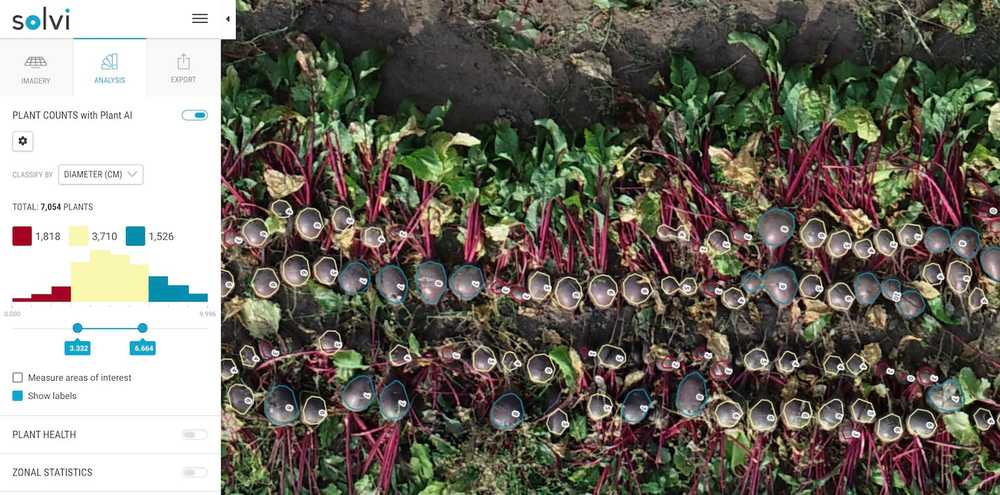
2. Plant-Level Data For Vegetable Crops
Solvi’s Zonal Statistics allows Rijk Zwaan’s researchers to quickly identify and visually subdivide trial plots. Users can then investigate and compare plant-level data within and between plots. This new data provides breeders with insights previously too time-consuming to measure but immensely valuable to improve selection accuracy.
Plant Health from Vegetation Index Mapping
Rijk Zwaan is evaluating near-infrared and red-edge bands from multispectral sensors to uncover vegetable disease symptoms (and also resistance) before they can be seen, something challenging to do in the field.
They are testing a number of vegetation indices for trait correlations and use in their breeding workflow: NDVI, NDRE, GLI, SAVI, VARI, and GRVI. Zonal Statistics allows researchers to apply any of these standard indices or to create a custom index.
Planting Density
Germination rate and sowing density are key metrics for most direct-sown vegetables. Rijk Zwaan’s researchers use the Plant AI™ tool to quantify and evaluate how sowing densities affect final crop size at harvest time.
Trait Expression Over Time
Amassing plot data from multiple flights adds dimension to Rijk Zwaan’s trials. If researchers notice something interesting in a specific breeding line, they can easily look back across dates to see how a phenotype changes with time. Solvi’s annotation tool makes map commenting and reviewing a snap.
Solvi’s Zonal Statistics tool is flexible enough to define the smallest unit of measurement at plot-level or plant-level, and this offers an easy way to extract data insights from drone imagery,” Woo said. “The color-coded zones for each plot metric quickly highlight any environmental or genetic variation on the overview map.
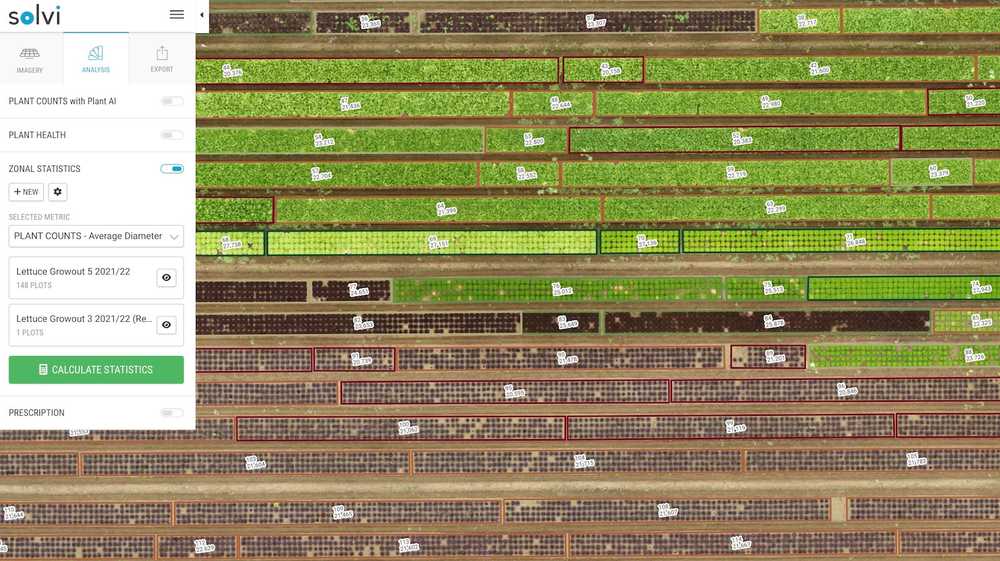
Drone Monitoring Vegetable Crop Stages
Area of inquiry, plant life cycle and production practices dictate drone inspection timing. For their vegetable breeding trials, Rijk Zwaan uses drone data to monitor:
- Seedling stage (transplanted crops)
- Germination counts
- Establishment
- Emergence (direct-sown crops)
- Germination counts
- Crop maturity (lettuce, brassicas)
- Crop indices for trait evaluation (size, shape, color, density, growth habit)
- Post-harvest (melons, carrots, beets)
- Crop/fruit counts and sizing
Every vegetable crop also has a very different crop physiology and as a result, different traits of interest, which means vegetable trial work is highly variable and can be quite different every day of the week,” Woo said. “For that reason, we utilize a range of phenotyping technologies and software solutions to study different crop traits, including Solvi’s impressive cloud-based software service.
Trial Plot Drone Inspection Outcomes
- Efficient, objective trial crop maps
- Quantitative data sets for in-season and multi-season comparisons
- New plant-level insights to better identify trait patterns
- Fewer hidden variables which could potentially alter evaluations
- Improved data confidence for variety selection and production
- Easy collaboration among large-scale, remote team
Future Plans
Rijk Zwaan continues to diversify the number and types of vegetable species they produce to meet their growers’ and consumers’ needs. This complexity and precision demand automation.
The need for drone analytics will continue to increase as Rijk Zwaan’s vegetable portfolio grows, and the possibilities to work on integrated end-to-end data extraction using Solvi, RTK drones and tractors need to be further explored,” Poodt said. “We look forward to the many exciting developments in the works from Solvi and how we can collaborate more closely in the future.
Benefits of Solvi Analytics
Plant-Level Data for Vegetable Crops
Diversified specialty crop growers need tools that work for every crop they grow. Rijk Zwaan’s researchers move between varieties, geographies, and field or greenhouse conditions.
Solvi’s drone crop mapping and analytics go everywhere their drone pilots do, providing detailed vegetable insights in a fraction of the time.
- Complete all in one cloud-based platform. No 3rd party software needed.
- Flexible to work with any RGB or multispectral camera and drone combination.
- Simple four-step imagery upload process.
- Highly accurate plant counts and health analytics.
- Clear, visual plot boundary maps and data results for research reports.
- Easy online file sharing for full team access.
- Fast 30-60 minute image processing for immediate analysis.
Solvi is very easy for a new user to quickly pick up,” Poodt said. “And the user-support experience from Solvi is the best by far for all SaaS solutions we have used in the past.
